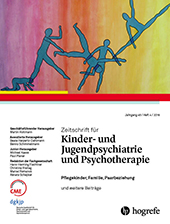Modifikation von Parent-Child Interaction Therapy (PCIT) für ältere Kinder: ein Fallbericht
Abstract
Abstract. Parent-Child Interaction Therapy (PCIT) is an evidence-based intervention designed for families of 2- to 6-year-old children with disruptive behavior disorders. This article illustrates the application of PCIT in a 10-year-old boy with attention deficit/hyperactivity disorder (ADHD) and oppositional defiant disorder (ODD). Both parents and the patient attended PCIT sessions. The course of therapy included minor changes to the PCIT protocol. After 13 PCIT sessions, the patient displayed disruptive behaviors within normal limits, and 12 months later he no longer met diagnostic criteria for ODD. Results remained stable at a 17-month follow-up assessment. This case study suggests that the use of PCIT in families of children with ODD markedly older than the recommended age range might be a promising approach for improving family functioning and reducing behavior problems. Further research with larger samples of older children with ODD is needed to replicate and elaborate the findings of this case study.
Zusammenfassung. Parent-Child Interaction Therapy (PCIT) stellt eine evidenz-basierte Intervention dar, die für die Behandlung von 2-6jährigen Kindern mit expansiven Verhaltensstörungen entwickelt wurde. Der vorliegende Fallbericht beschreibt die Behandlung eines 10jährigen Jungen mit kombinierter oppositionell-verweigernder Störung des Sozialverhaltens und Aktivitäts- und Aufmerksamkeitsstörung mittels PCIT. An der Behandlung nahmen beide Eltern und der Patient teil, es waren dabei nur kleinere Modifikationen des Standardvorgehens erforderlich. Nach 13 PCIT-Sitzungen zeigte der Patient kein auffälliges expansives Verhalten mehr, 12 Monate später erfüllte er auch nicht mehr die diagnostischen Kriterien einer Störung des Sozialverhaltens. Diese Veränderungen waren auch noch 17 Monate nach Behandlungsende stabil. Der Fallbericht zeigt, dass PCIT auch bei deutlich älteren Kindern mit oppositionell-verweigernder Störung des Sozialverhaltens eine erfolgversprechende Behandlungsform sein könnte, um das familiäre Miteinander zu verbessern und kindliche Verhaltensprobleme zu reduzieren. Allerdings sind Studien mit größerer Fallzahl erforderlich, um die Ergebnisse dieses Fallberichts zu überprüfen.
Literature
(1967). Child care practices anteceding three patterns of preschool behavior. Genetic Psychology Monographs, 75, 43–88.
(2016). Parent-Child Interaction Therapy. Zeitschrift für Kinder- und Jugendpsychiatrie und Psychotherapie, 44, 455–465.
(2015). Parent-Child Interaction Therapy im In-room Coaching. Kindheit und Entwicklung, 24, 47–54.
(2012). Parent-child interaction therapy as a family-oriented approach to behavioral management following pediatric traumatic brain injury: A case report. Journal of Pediatric Psychology, 37, 251–261.
(1988). Parent-child interaction therapy: Integration of traditional and behavioral concerns. Child and Family Behavior Therapy, 10, 33–46.
(2011). Parent-Child Interaction Protocol. PCIT International Inc.
(1999). PCIT: Parent Child Interaction Therapy. Integrity checklists and session materials. Version 2.09. Gainesville, FL: University of Florida.
(2010). Abbreviated manual of the Dyadic Parent-Child Interaction Coding System (DPICS). Version 3.09. Gainesville, FL: University of Florida.
(2013). Dyadic Parent-Child Interaction Coding System (DPICS). Comprehensive manual for research and training (4th ed.). PCIT International.
(1999). Eyberg Child Behavior Inventory and Sutter Eyberg Student Behavior Inventory – Revised: Professional manual. Odessa, FL: Psychological Assessment Resources.
(2014). The assessment of child behavior problems with the German version of the Eyberg Child Behavior Inventory (ECBI). Diagnostica, 60, 197–210.
(1991). Clinical significance: A statistical approach to defining meaningful change in psychotherapy research. Journal of Consulting and Clinical Psychology, 59, 12–19.
(2009). Kaufman Assessment Battery for Children (8th edition, German version by P. Melchers and U. Preuß). Frankfurt am Main: Pearson Assessment.
(2010). Parent-Child Interaction Therapy (2nd ed.). New York: Springer.
(2009). Kinder-DIPS: Diagnostisches Interview bei psychischen Störungen im Kindes- und Jugendalter. Heidelberg: Springer Medizin Verlag.
(2002). Normierung und Evaluation der deutschen Elternversion des Strengths and Difficulties Questionnaire (SDQ): Ergebnisse einer repräsentativen Felderhebung. Zeitschrift für Kinder- und Jugendpsychiatrie und Psychotherapie, 30, 105–112.



